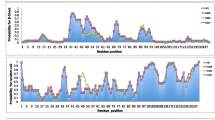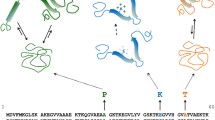Abstract
Misfolding and aggregation of proteins are common threads linking a number of important human health problems, including various neurodegenerative disorders such as Parkinson’s disease in particular. The first and perhaps most important elements in most neurodegenerative processes are misfolding and aggregation of specific proteins. Despite the crucial importance of protein misfolding and abnormal interactions, very little is currently known about the molecular mechanism underlying these processes. Factors that lead to protein misfolding and aggregation in vitro are poorly understood, in addition to the complexities involved in the formation of protein nanoparticles with different morphologies (e.g. nanopores and other species) in vivo. A clear understanding of the molecular mechanisms of misfolding and aggregation will facilitate rational approaches to prevent protein misfolding mediated pathologies. To accomplish this goal and to elucidate the mechanism of protein misfolding, we developed a novel nanotechnology tool capable of detecting protein misfolding. We applied single molecule probing technique to characterize misfolding and self-assembly of α-synuclein dimers, which is the very first step of the aggregation process. Using AFM force spectroscopy approach, we were able to detect protein misfolding via enhanced interprotein interaction. Moreover, such an important characteristic as the lifetime of dimers formed by misfolded α-synuclein was measured. These data suggest that compared to highly dynamic monomeric forms, α-synuclein dimers are practically static and thus can play a role of aggregation nuclei for the formation of aggregates. Importantly, two different dissociation channels were detected suggesting that aggregation process can follow different pathways. The application of these findings for understanding of the aggregation phenomenon and the development of the disease is discussed.



Similar content being viewed by others
References
Bell GI (1978) Models for the specific adhesion of cells to cells. Science 200:618–627 doi:10.1126/science.347575
Croisier E, Moran LB, Dexter DT, Pearce RK, Graeber MB (2005) Microglial inflammation in the parkinsonian substantia nigra: relationship to alpha-synuclein deposition. J Neuroinflammation 2:14 doi:10.1186/1742-094-2-14
Demidov VV (2004) Proper refolding helps express “difficult” proteins. Drug Discov Dev 7:41–47
Dobson CM (2003) Protein folding and misfolding. Nature 426:884–890 doi:10.1038/nature02261
Dobson CM (2004) Principles of protein folding, misfolding and aggregation. Semin Cell Dev Biol 15:3–16 doi:10.1016/j.semcdb.2003.12.008
Duda JE, Lee VM, Trojanowski JQ (2000) Neuropathology of synuclein aggregates. J Neurosci Res 61:121–127 doi:10.1002/1097-4547(20000715)61:2<121::AID-JNR1>3.0.CO;2-4
Evans E, Ritchie K (1997) Dynamic strength of molecular adhesion bonds. Biophys J 72:1541–1555
Fink AL (1998) Protein aggregation: folding aggregates, inclusion bodies and amyloid. Fold Des 3:R9–R23 doi:10.1016/S1359-0278(98)00002-9
Friedsam C, Wehle AK, Kuhner F, Gaub HE (2003) Dynamic single-molecule force spectroscopy: bond rupture analysis with variable spacer length. J Phys Condens Matter 15:S1709–S1723 doi:10.1088/0953-8984/15/18/305
Giasson BI, Duda JE, Murray IV, Chen Q, Souza JM, Hurtig HI et al (2000) Oxidative damage linked to neurodegeneration by selective alpha-synuclein nitration in synucleinopathy lesions. Science 290:985–989 doi:10.1126/science.290.5493.985
Gitler AD, Bevis BJ, Shorter J, Strathearn KE, Hamamichi S, Su L et al (2008) The Parkinson’s disease protein alpha-synuclein disrupts cellular Rab homeostasis. Proc Natl Acad Sci USA 105:145–150 doi:10.1073/pnas.0710685105
Hashimoto M, Hsu LJ, Sisk A, Xia Y, Takeda A, Sundsmo M et al (1998) Human recombinant NACP/a-synuclein is aggregated and fibrillated in vitro: relevance for Lewy body disease. Brain Res 799:301–306 doi:10.1016/S0006-8993(98)00514-9
Heise H, Hoyer W, Becker S, Andronesi OC, Riedel D, Baldus M (2005) Molecular-level secondary structure, polymorphism, and dynamics of full-length a-synuclein fibrils studied by solid-state NMR. Proc Natl Acad Sci USA 102:15871–15876 doi:10.1073/pnas.0506109102
Heymann B, Grubmuller H (2000) Dynamic force spectroscopy of molecular adhesion bonds. Phys Rev Lett 84:6126–6129 doi:10.1103/PhysRevLett.84.6126
Hofrichter J, Ross PD, Eaton WA (1974) Kinetics and mechanism of deoxyhemoglobin S gelation: a new approach to understanding sickle cell disease. Proc Natl Acad Sci USA 71:4864–4868 doi:10.1073/pnas.71.12.4864
Jarrett JT, Lansbury PT Jr (1993) Seeding “one-dimensional crystallization” of amyloid: a pathogenic mechanism in Alzheimer’s disease and scrapie? Cell 73:1055–1058 doi:10.1016/0092-8674(93)90635-4
Kransnoslobodtsev AV, Shlyakhtenko LS, Ukraintsev E, Zaikova TO, Keana JFW, Lyubchenko YL (2005) Nanomedicine and protein misfolding diseases. Nanomedicine 1:300–305 doi:10.1016/j.nano.2005.10.005
Krasnoslobodtsev AV, Shlyakhtenko LS, Lyubchenko YL (2007) Probing interactions within the synaptic DNA-Sfil complex by AFM force spectroscopy. J Mol Biol 365:1407–1416 doi:10.1016/j.jmb.2006.10.041
Krishnan S, Chi EY, Wood SJ, Kendrick BS, Li C, Garzon-Rodriguez W et al (2003) Oxidative dimer formation is the critical rate-limiting step for Parkinson’s disease alpha-synuclein fibrillogenesis. Biochemistry 42:829–837 doi:10.1021/bi026528t
Kuhner F, Costa LT, Bisch PM, Thalhammer S, Heckl WM, Gaub HE (2004) LexA-DNA bond strength by single molecule force spectroscopy. Biophys J 87:2683–2690 doi:10.1529/biophysj.104.048868
Lyubchenko YL, Sherman S, Shlyakhtenko LS, Uversky VN (2006) Nanoimaging for protein misfolding and related diseases. J Cell Biochem 99:52–70 doi:10.1002/jcb.20989
McAllister C, Karymov MA, Kawano Y, Lushnikov AY, Mikheikin A, Uversky VN et al (2005) Protein interactions and misfolding analyzed by AFM force spectroscopy. J Mol Biol 354:1028–1042 doi:10.1016/j.jmb.2005.10.012
Meyer-Luehmann M, Spires-Jones TL, Prada C, Garcia-Alloza M, de Calignon A, Rozkalne A et al (2008) Rapid appearance and local toxicity of amyloid-beta plaques in a mouse model of Alzheimer’s disease. Nature 451:720–724 doi:10.1038/nature06616
Munoz V (2007) Conformational dynamics and ensembles in protein folding. Annu Rev Biophys Biomol Struct 36:395–412 doi:10.1146/annurev.biophys.36.040306.132608
Ptitsyn OB (1995) Molten globule and protein folding. Adv Protein Chem 47:83–229 doi:10.1016/S0065-3233(08)60546-X
Ray C, Brown JR, Akhremitchev BB (2006) Single-molecule force spectroscopy measurements of “hydrophobic bond” between tethered hexadecane molecules. J Phys Chem B 110:17578–17583 doi:10.1021/jp063517r
Ray C, Brown JR, Akhremitchev BB (2007a) Correction of systematic errors in single-molecule force spectroscopy with polymeric tethers by atomic force microscopy. J Phys Chem B 111:1963–1974 doi:10.1021/jp065530h
Ray C, Brown JR, Akhremitchev BB (2007b) Rupture force analysis and the associated systematic errors in force spectroscopy by AFM. Langmuir 23:6076–6083 doi:10.1021/la070131e
Segel DJ, Eliezer D, Uversky V, Fink AL, Hodgson KO, Doniach S (1999) Transient dimer in the refolding kinetics of cytochrome c characterized by small-angle X-ray scattering. Biochemistry 38:15352–15359 doi:10.1021/bi991337k
Selvin PR, Ha T (2007) Single molecule techniques. Cold Spring Harbor Laboratory, New York
Shlyakhtenko LS, Gall AA, Filonov A, Cerovac Z, Lushnikov A, Lyubchenko YL (2003) Silatrane-based surface chemistry for immobilization of DNA, protein-DNA complexes and other biological materials. Ultramicroscopy 97:279–287 doi:10.1016/S0304-3991(03)00053-6
Souza JM, Giasson BI, Lee VM, Ischiropoulos H (2000) Chaperone-like activity of synucleins. FEBS Lett 474:116–119 doi:10.1016/S0014-5793(00)01563-5
Spillantini MG, Schmidt ML, Lee VMY, Trojanowski JQ, Jakes R, Goedert M (1997) alpha-synuclein in Lewy bodies. Nature 388:839–840 doi:10.1038/42166
Stefani M, Dobson CM (2003) Protein aggregation and aggregate toxicity: new insights into protein folding, misfolding diseases and biological evolution. J Mol Med 81:678–699 doi:10.1007/s00109-003-0464-5
Tsigelny IF, Bar-On P, Sharikov Y, Crews L, Hashimoto M, Miller MA et al (2007) Dynamics of a-synuclein aggregation and inhibition of pore-like oligomer development by b-synuclein. FEBS J 274:1862–1877 doi:10.1111/j.1742-4658.2007.05733.x
Ulmer TS, Bax A, Cole NB, Nussbaum RL (2005) Structure and dynamics of micelle-bound human a-synuclein. J Biol Chem 280:9595–9603 doi:10.1074/jbc.M411805200
Uversky VN, Karnoup AS, Khurana R, Segel DJ, Doniach S, Fink AL (1999) Association of partially-folded intermediates of staphylococcal nuclease induces structure and stability. Protein Sci 8:161–173
Uversky VN, Li J, Fink AL (2001) Evidence for a partially folded intermediate in a-synuclein fibril formation. J Biol Chem 276:10737–10744 doi:10.1074/jbc.M010907200
Uversky VN, Kabanov AV, Lyubchenko YL (2006) Nanotools for megaproblems: probing protein misfolding diseases using nanomedicine modus operandi. J Proteome Res 5:2505–2522 doi:10.1021/pr0603349
Walsh DM, Selkoe DJ (2004a) Deciphering the molecular basis of memory failure in Alzheimer’s disease. Neuron 44:181–193 doi:10.1016/j.neuron.2004.09.010
Walsh DM, Selkoe DJ (2004b) Oligomers on the brain: the emerging role of soluble protein aggregates in neurodegeneration. Protein Pept Lett 11:213–228 doi:10.2174/0929866043407174
Walsh DM, Selkoe DJ (2007) A beta oligomers—a decade of discovery. J Neurochem 101:1172–1184 doi:10.1111/j.1471-4159.2006.04426.x
Walsh DM, Klyubin I, Shankar GM, Townsend M, Fadeeva JV, Betts V et al (2005) The role of cell-derived oligomers of Abeta in Alzheimer’s disease and avenues for therapeutic intervention. Biochem Soc Trans 33:1087–1090 doi:10.1042/BST20051087
Acknowledgements
We would like to thank A. Fink for the α-synuclein, S. Malkova for participation in initial experiments, A. Krasnoslobodtsev, L. Shlyakhtenko, and V. Uversky for useful suggestions and A. Portillo for the proofreading of the manuscript. This work was supported by NIH and NRI grants to YLL.
Author information
Authors and Affiliations
Corresponding author
Rights and permissions
About this article
Cite this article
Yu, J., Lyubchenko, Y.L. Early Stages for Parkinson’s Development: α-Synuclein Misfolding and Aggregation. J Neuroimmune Pharmacol 4, 10–16 (2009). https://doi.org/10.1007/s11481-008-9115-5
Received:
Accepted:
Published:
Issue Date:
DOI: https://doi.org/10.1007/s11481-008-9115-5




